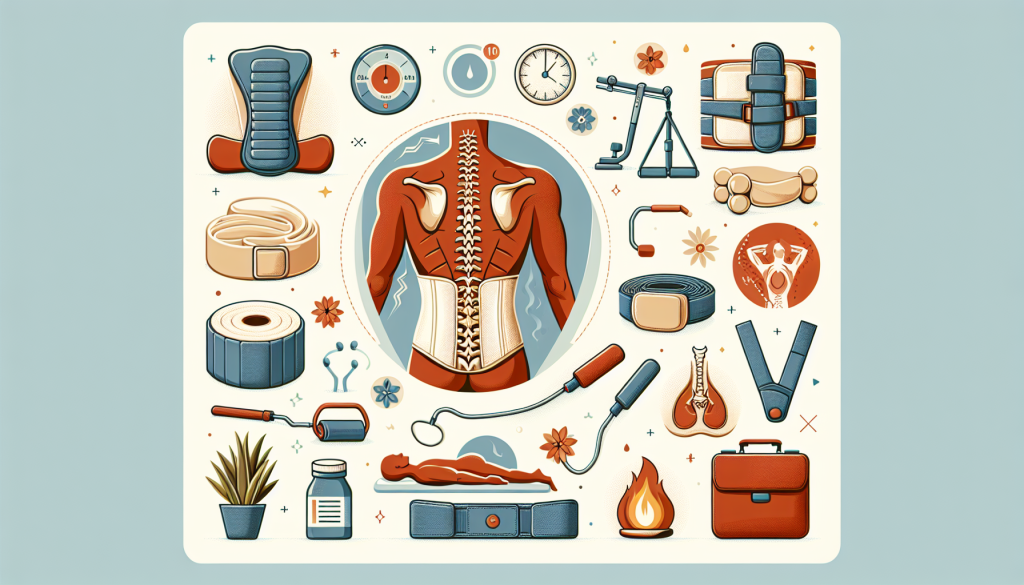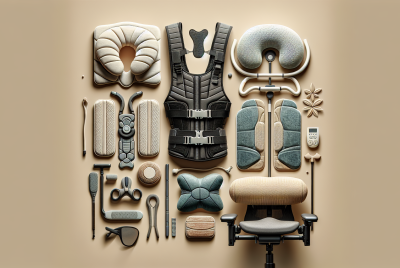Ultimate Buyers Guide For Back Pain Relief Aids
Are you tired of suffering from persistent back pain? If so, you’re not alone. Back pain affects millions of people worldwide, making it a common and frustrating issue. Fortunately, there are various back pain relief aids available in the market to help alleviate your discomfort and improve your quality of life. In this ultimate buyer’s guide, we will explore a wide range of back pain relief aids, providing you with valuable information on their features, benefits, and effectiveness. Whether you’re looking for ergonomic chairs, lumbar support pillows, or heat therapy wraps, this guide will help you make an informed decision and find the perfect solution for your needs. Say goodbye to back pain and hello to a healthier, more comfortable life!
Types of Back Pain Relief Aids
When it comes to finding relief for your back pain, there are numerous options available. Here are some of the most common types of back pain relief aids:
1. Medications
Medications such as nonsteroidal anti-inflammatory drugs (NSAIDs), muscle relaxants, and prescription pain relievers can help alleviate back pain. However, it’s important to consult with a healthcare professional before taking any medications to ensure they are safe and suitable for your specific condition.
2. Topical Treatments
Topical treatments such as creams, gels, and ointments can provide temporary relief by numbing the area or reducing inflammation. These products are applied directly to the skin over the affected area and can be a convenient option for localized pain.
3. Heat and Cold Therapy
Applying heat or cold to the affected area can help alleviate back pain. Heat therapy, such as hot packs or heating pads, can help relax muscles and improve blood flow, while cold therapy, such as ice packs, can reduce inflammation and numb the area.
4. Back Support Products
Back support products, such as lumbar cushions, back braces, and posture correctors, can help provide support and align the spine properly, reducing strain and relieving back pain. These aids can be especially beneficial for individuals who spend long hours sitting or standing.
5. Physical Therapy Devices
Physical therapy devices, such as foam rollers, exercise balls, and resistance bands, can aid in strengthening the muscles surrounding the spine and improving flexibility. These aids can be used to complement a physical therapy treatment plan and provide long-term relief from back pain.
6. TENS Units
Transcutaneous electrical nerve stimulation (TENS) units use low-voltage electrical currents to stimulate the nerves and provide pain relief. These portable devices can be attached to the skin and are a non-invasive option for managing back pain.
7. Massage Chairs
Massage chairs can provide relief by using various massage techniques to relax muscles, reduce tension, and promote circulation. These chairs often come with adjustable settings and can be a convenient option for individuals seeking regular massages for back pain relief.
8. Acupuncture and Acupressure Tools
Acupuncture and acupressure tools, such as acupuncture mats and acupressure balls, can help target specific pressure points to relieve back pain. These tools simulate the effects of acupuncture or acupressure therapy and can be used at home for self-treatment.
9. Inversion Tables
Inversion tables allow individuals to hang upside down and decompress the spine, which can help relieve pressure and reduce back pain. However, it’s crucial to consult with a healthcare professional before using an inversion table, as it may not be suitable for everyone.
10. Back Braces
Back braces provide support and stability to the lower back, reducing strain and promoting proper posture. These braces can be beneficial for individuals recovering from injuries or those who require additional support during physical activities.
Factors to Consider Before Buying Back Pain Relief Aids
Before purchasing any back pain relief aids, there are several factors you should take into consideration to ensure the product is suitable for your needs. These factors include:
1. Type and Severity of Back Pain
Consider the type and severity of your back pain to determine which relief aid will be most effective. Whether you’re experiencing muscle tension, inflammation, or chronic pain, understanding the nature of your condition will help you choose the right product.
2. Safety and Side Effects
Ensure that the back pain relief aid you’re considering is safe for use and does not pose any potential risks or side effects. It’s important to read the product instructions and consult with a healthcare professional if necessary.
3. Personal Preferences and Comfort
Consider your personal preferences and comfort when choosing a back pain relief aid. Whether you prefer heat therapy over cold therapy or have a specific preference for a certain type of device, finding a product that aligns with your preferences will enhance your overall experience.
4. Budget
Establish a budget for purchasing a back pain relief aid. Some products may be more expensive than others, so it’s important to consider the long-term costs and benefits before making a decision.
5. Ease of Use
Consider the ease of use of the relief aid. Some products may require additional assembly or complicated instructions, while others are simple and straightforward. Choose a product that is convenient and user-friendly.
6. Portability
If you plan on using the relief aid while on the go or during travel, consider the portability of the product. Some aids are compact and lightweight, while others may be bulkier and less travel-friendly.
7. Durability and Longevity
Investigate the durability and longevity of the back pain relief aid. Look for products that are well-constructed and made from high-quality materials to ensure they will withstand regular use over time.
8. User Reviews and Ratings
Read user reviews and ratings to get an idea of the effectiveness and overall satisfaction of the back pain relief aid. Hearing from others who have used the product can provide valuable insight and help you make an informed decision.
9. Expert Recommendations
Consider seeking expert recommendations from healthcare professionals, physical therapists, or chiropractors. These professionals can provide guidance based on your specific condition and help steer you towards the most suitable relief aid.
10. Return and Warranty Policies
Lastly, check the return and warranty policies of the back pain relief aid. It’s important to have the option to return or exchange the product if it does not meet your expectations or if any issues arise. Additionally, a warranty can provide peace of mind regarding any potential defects or malfunctions.

Important Features to Look for in Back Pain Relief Aids
When considering back pain relief aids, there are several important features you should look for to ensure you choose a product that will effectively alleviate your pain. These features include:
1. Adjustable Settings and Intensity Levels
Look for relief aids that offer adjustable settings and intensity levels. This allows you to customize the aid to suit your preferences and gradually increase or decrease the intensity as needed.
2. Ergonomic Design
Choose relief aids with an ergonomic design that provides proper support and aligns with the natural curves of your spine. An ergonomic design can optimize the efficacy of the aid and minimize discomfort.
3. Customization Options
Consider relief aids that offer customization options to cater to your specific needs. Whether it’s adjustable straps, removable or interchangeable parts, or customizable settings, having options will enhance your experience and ensure a proper fit.
4. Multiple Functions and Modes
Look for relief aids that offer multiple functions and modes. This versatility allows you to target different types of pain or choose a mode that best suits your preference.
5. Ease of Assembly
Choose relief aids that are easy to assemble and use. Complicated assembly can be frustrating and time-consuming, so opt for aids that require minimal effort to set up.
6. User-Friendly Controls
Consider relief aids with user-friendly controls that are intuitive and easy to navigate. Clear instructions and well-labeled buttons or settings can enhance the overall user experience.
7. Rechargeable or Battery Operated
Decide whether you prefer a relief aid that is rechargeable or battery operated. Rechargeable aids can be more cost-effective and environmentally friendly, while battery-operated aids provide convenience and portability.
8. FDA Approval and Certifications
Ensure that the relief aid you choose has received approval from relevant regulatory bodies, such as the U.S. Food and Drug Administration (FDA). Certifications and endorsements from reputable organizations can provide reassurance regarding the safety and effectiveness of the aid.
9. Size and Fit
Consider the size and fit of the relief aid, especially if it is worn or used in a specific area of the body. The aid should be adjustable and have a secure fit to ensure optimal relief without causing discomfort.
10. Additional Accessories and Attachments
Look for relief aids that come with additional accessories or attachments that enhance the functionality or versatility of the product. This can include extra pads, straps, or attachments that cater to specific pain areas or offer additional relief options.
Specific Considerations for Different Types of Back Pain Relief Aids
Different types of back pain relief aids require specific considerations when choosing the right one for your needs. Here are some specific considerations for each type of aid:
1. Medications
When considering medications for back pain relief, consult with a healthcare professional to determine the most suitable option based on your specific condition and medical history. Consider any potential side effects or interactions with other medications you may be taking.
2. Topical Treatments
Check the active ingredients in topical treatments and read user reviews to determine their effectiveness. Consider whether you prefer a warming or cooling sensation and choose a product accordingly.
3. Heat and Cold Therapy
Decide whether you prefer heat or cold therapy for your back pain and choose a relief aid accordingly. Consider the length of time the aid can provide heat or cold therapy and ensure it is safe to use on the skin.
4. Back Support Products
Opt for back support products that offer adjustable straps or customizable features to ensure a proper fit. Consider the level of support provided and whether the product is suitable for your specific needs, such as sitting for long periods or engaging in physical activities.
5. Physical Therapy Devices
When choosing physical therapy devices, consult with a physical therapist or healthcare professional to ensure they are appropriate for your specific condition. Consider the level of difficulty or resistance offered by the device and choose one that suits your current fitness level.
6. TENS Units
Look for TENS units with adjustable settings and intensity levels. Consider the type and placement of electrodes and ensure they provide effective stimulation for your specific pain area.
7. Massage Chairs
Test out different massage chairs to find one that suits your preferences and provides adequate relief. Consider the range of massage techniques and adjustability options offered by the chair.
8. Acupuncture and Acupressure Tools
Choose acupuncture and acupressure tools that target your specific pressure points. Consider whether you prefer tools with spikes, balls, or mats, and ensure they are made from high-quality materials.
9. Inversion Tables
Consult with a healthcare professional before using an inversion table and ensure it is suitable for your specific condition. Consider the weight capacity, adjustability, and safety features of the table.
10. Back Braces
Ensure that back braces provide adequate support and stability for your specific needs. Consider the level of compression and adjustability offered by the brace.

Where to Buy Back Pain Relief Aids
Back pain relief aids are available from various sources. Here are some popular places to purchase these aids:
1. Local Pharmacies and Drugstores
Local pharmacies and drugstores often carry a selection of back pain relief aids. These establishments offer convenience and allow you to speak with a pharmacist for recommendations or guidance.
2. Specialty Medical Stores
Specialty medical stores may offer a wider range of back pain relief aids and cater specifically to individuals with medical conditions. These stores often have knowledgeable staff who can provide expert advice.
3. Online Retailers
Online retailers provide a wide selection of back pain relief aids and allow you to browse and compare products from the comfort of your home. Ensure to choose reputable and trustworthy online retailers when making purchases.
4. Healthcare Providers and Physical Therapists
Consult with healthcare providers or physical therapists who may recommend specific back pain relief aids based on your condition. These professionals may also have products available for purchase or be able to refer you to reputable suppliers.
5. Secondhand Options
Consider purchasing back pain relief aids from secondhand sources, such as online marketplaces or local classifieds, to potentially save money. However, exercise caution and ensure the products are in good condition and meet your safety and effectiveness requirements.
Tips for Comparing and Choosing Back Pain Relief Aids
With numerous back pain relief aids available, it can be challenging to choose the right one for your needs. Here are some helpful tips for comparing and selecting these aids:
1. Read and Compare Product Reviews
Read product reviews from other customers to gain insights into the effectiveness and overall satisfaction of the relief aid. Comparing reviews can help you make an informed decision and avoid potential pitfalls.
2. Consult with Healthcare Professionals
Consult with healthcare professionals or seek recommendations from physical therapists, chiropractors, or other medical experts. These professionals can provide personalized advice based on your specific condition and guide you toward the most suitable relief aid.
3. Check for Clinical Studies and Research
Look for clinical studies or scientific research that supports the effectiveness of the back pain relief aid you’re considering. Scientific evidence can provide reassurance and substantiate the claims made by the manufacturer.
4. Test the Product if Possible
If feasible, try out the back pain relief aid before making a purchase. Whether it’s testing the comfort of a back brace, trying out different massage chairs, or experiencing a TENS unit’s sensation, firsthand experience can provide valuable information.
5. Compare Prices and Value for Money
Consider the overall value for money when comparing back pain relief aids. Compare the price of the aid with its features, effectiveness, and durability to ensure you’re getting the best value for your investment.
6. Consider Personal Recommendations
Seek recommendations from family, friends, or colleagues who have used back pain relief aids. Personal experiences and recommendations can provide valuable insights and help you make a well-informed decision.
7. Look for Money-Back Guarantees
Choose relief aids that come with money-back guarantees or return policies. This ensures that you can return or exchange the product if it does not meet your expectations or provide the desired relief.
8. Research and Understand Different Warranty Terms
Read and understand the warranty terms provided by the manufacturer. Different products may have varying warranty lengths or cover different types of defects. Knowing the warranty terms can provide peace of mind regarding potential issues with the aid.
9. Read and Understand Return Policies
Carefully read and understand the return policies of the retailer or online marketplace from which you’ll be purchasing the back pain relief aid. Ensure that you can return the product if it is not suitable or if any issues arise.
10. Trust Your Instincts
Ultimately, trust your instincts and choose a back pain relief aid that feels right for you. Everyone’s preferences and needs are different, so it’s important to select an aid that aligns with your intuition and personal requirements.
In conclusion, finding the right back pain relief aid involves considering the type and severity of your pain, along with factors such as safety, comfort, budget, and ease of use. Important features to look for include adjustability, ergonomic design, customization options, and multiple functions. Each type of relief aid has its own specific considerations, and it’s important to purchase from reputable sources and compare products wisely. By following these tips and listening to your instincts, you can make an informed decision and find the back pain relief aid that works best for you.




